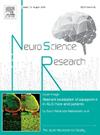Microglial colonization routes and their impacts on cellular diversity
IF 2.4
4区 医学
Q3 NEUROSCIENCES
引用次数: 0
Abstract
Microglia are the resident immune cells of the central nervous system. Unlike other glial cells—such as astrocytes and oligodendrocytes—which originate from neural stem cells alongside neurons, microglia derive from erythromyeloid progenitors that emerge in the yolk sac during early embryonic development. Once they reach the brain, microglia expand their population through proliferation during development. A growing body of research has revealed that microglia play diverse roles throughout life, both in physiological and pathological contexts. With recent advancements in single-cell transcriptomics, it has become increasingly evident that microglia exhibit substantial heterogeneity in their gene expression patterns. While various functions and subtypes of microglia are being uncovered, the mechanisms underlying their diversity remain largely unknown. Two key hypotheses may explain how microglial diversity arises. One possibility is that their diversity is influenced by the different colonization routes they take before settling in the brain. Alternatively, microglia may acquire distinct properties in response to their local environment. This review explores both possibilities, with a particular focus on the first hypothesis, drawing on recent findings that highlight the multiple routes microglia utilize to colonize the brain. It discusses how these processes contribute to the establishment of microglial diversity during brain development.
小胶质细胞定植途径及其对细胞多样性的影响。
小胶质细胞是中枢神经系统的常驻免疫细胞。不同于其他的神经胶质细胞,如星形胶质细胞和少突胶质细胞,它们来源于神经干细胞和神经元,小胶质细胞来源于胚胎发育早期卵黄囊中出现的红髓祖细胞。一旦它们到达大脑,小胶质细胞在发育过程中通过增殖来扩大它们的数量。越来越多的研究表明,小胶质细胞在整个生命过程中发挥着不同的作用,无论是在生理上还是在病理上。随着单细胞转录组学的最新进展,越来越明显的是,小胶质细胞在其基因表达模式上表现出实质性的异质性。虽然小胶质细胞的各种功能和亚型正在被发现,但其多样性背后的机制在很大程度上仍然未知。两个关键假设可以解释小胶质细胞多样性是如何产生的。一种可能性是,它们的多样性受到它们在大脑中定居之前所采取的不同殖民路线的影响。另一种情况是,小胶质细胞可能会根据局部环境获得不同的特性。这篇综述探讨了这两种可能性,特别关注第一种假设,借鉴了最近的发现,强调了小胶质细胞利用多种途径在大脑中定居。它讨论了这些过程在大脑发育过程中如何促进小胶质细胞多样性的建立。
本文章由计算机程序翻译,如有差异,请以英文原文为准。
求助全文
约1分钟内获得全文
求助全文
来源期刊

Neuroscience Research
医学-神经科学
CiteScore
5.60
自引率
3.40%
发文量
136
审稿时长
28 days
期刊介绍:
The international journal publishing original full-length research articles, short communications, technical notes, and reviews on all aspects of neuroscience
Neuroscience Research is an international journal for high quality articles in all branches of neuroscience, from the molecular to the behavioral levels. The journal is published in collaboration with the Japan Neuroscience Society and is open to all contributors in the world.
 求助内容:
求助内容: 应助结果提醒方式:
应助结果提醒方式:


